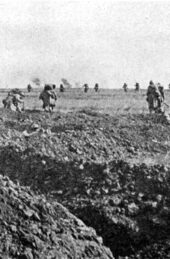By the third year of the First World War, France was growing increasingly war weary. Over a million men had been killed, wounded or captured, with little to show for it. Russia had had a revolution and unrest was spreading through the French Army, fanned by turmoil at home, lack of leave and German propaganda. The failure of the Nivelle Offensive was the last straw and lead to what has become known as the Mutiny of the French Army.
The French had borne the brunt of the fighting on the Western Front while Britain’s new armies were created. By 1917 there was a growing feeling among French troops that their generals, the blood-drinkers, had little regard for their lives; which they were throwing away uselessly.
French soldiers returning to the front from leave brought back stories of food shortages, strikes and protests at home. Leave itself was a long-standing source of contention among the troops. When they actually got leave, much of it was wasted travelling home and left them very little time with their families.
The troops were given antiwar leaflets while in transit, by a growing number of far-left activists. The Germans were also engaged in a conspiracy to buy French newspapers to print antiwar propaganda and undermine France’s will to fight.
Nonetheless there was still a fighting spirit among the troops and Nivelle, the new Commander in Chief, managed to reinstall some optimism with his coming offensive – which he said would bring victory.
The offensive began on 16th April 1917 and was a costly failure, with over 130,000 casualties. The last hope went and by June much of the army was in a state of ‘mutiny’.
The early stages of the mutiny were largely drunken disturbances. Soldiers who thought of themselves as French citizen first and soldiers second, began to protest at the pointlessness of continuing the offensive.

French infantry advance
The actual term mutiny for these protests is still controversial, they could perhaps be best described as strikes for better treatment. The French authorities described them as ‘collective disobedience’. They fluctuated in size and scale, increasing in seriousness through May and June 1917; and ranged from protests and riots, to refusal to attack and attempts to march on Paris and install a new government. These disturbances were however confined to the rest areas. The troops at the front continued to hold the line.
David Murphy in Breaking Point of the French Army: The Nivelle Offensive of 1917, states that the mutinies had four phases. The first began as early as the start of the Nivelle Offensive. These were generally small protests and a refusal to obey orders. By mid-May the protests began to spread and increase in magnitude, with entire divisions taking part in increasingly violent and desperate ‘collective disobedience’. The first week of June marked an escalation in the level of violence and it was evident the French army was barely able to function as a fighting force, with fifty-four divisions taking part in the protests. Discipline began to be restored by the end of June. Pétain, who had replaced Nivelle, regained control. He shot the ringleaders, but introduced reforms that improved the conditions of the troops. He also never launched another full scale offensive.
The great unknown about the mutinies is why the Germans didn’t exploit them. German intelligence did receive reports of disorder in the French lines, but they didn’t act on them. David Murphy suggests that it could have been that the Germans weren’t in a position to launch an offensive, or the reports simply weren’t believed. The French were also able to keep the full extent of the mutinies a secret, even from their Allies.

Alan Bardos is the author of Enemies & Allies, published by Sharpe Books.





